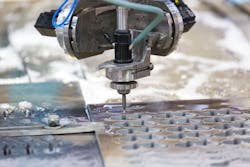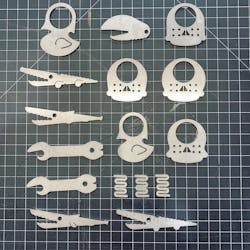Laser cutting and water jet are two commonly used cutting processes in manufacturing. Depending on the material required and the desired end result, one of these two methods may be more advantageous. Below, learn the fundamental differences between these processes and the applications in which both processes are best suited.
What is Water Jet Cutting?
Water jet cutting is a subtractive manufacturing technique that uses pressurized water focused at a small point to cut the material you are using. Pressure can be as high as 60,000 lb. per square inch. Water in this process can be mixed with an abrasive such as garnet, which can increase the number of materials you can use with this process and inhibits closer tolerances.
What is Laser Cutting?
Laser cutting is a precise subtractive process using a precisely focused beam of high-energy light to vaporize the material. Laser cutting enables a fine level of cutting detail on a wide variety of materials. There are 2 lasers commonly used in the laser cutting process: CO2 lasers and fiber lasers:
CO2 lasers-Very flexible lasers that can cut a multitude of materials, as long as the material is not too reflective. CO2 lasers require more power and maintenance than fiber lasers but allow more flexibility in the cutting process. Used for engraving, cutting and boring
Fiber lasers- Best when high energy and high repetition is required. Primarily used for cutting and boring when high speed is required.
What Materials Can be Used with Laser Cutting and Water Jet Cutting?
Both laser cutting and water jet can cut metals. Laser cutting is a great option for metals <.500-in. in thickness, especially .250 in. or less. However, laser cutting is not typically an option for thick metals or materials such as glass, stone, etc. The biggest drawback to the water jet process is that you cannot cut anything water-sensitive such as leather, cardboard or paper. Laser cutting, on the other hand, can be used to cut water-sensitive materials. While fiber lasers can only be used for metals, CO2 lasers can cut plastics, wood.
How do laser cutting and water jet cutting compare from a tolerance perspective?
Laser cutting offers greater precision than water jet cutting. Typical laser beam width (kerf) is about .005 in., where a waterjet might be closer to .030 in. That means that any acute angle will have a .015-in. radius with a waterjet, and on laser, the radius might only be .002-in.
Which cutting process is safer?
While both technologies are relatively safe, laser cutting is considered safer since the laser cutting operation occurs in an enclosed cabinet to shield the operator from the reflected laser light. Water jets are operated in a more open environment, so if a problem occurs with a high-pressure line there could be dangers.
What applications are advantageous for both technologies? Lasers excel at processing metals <.500-in. in thickness. Lasers are faster than water and don’t expose the metals to water (which could lead to rusting or oxidation). The water jet process is superior at processing metals greater than .750-in. in thickness. Water jet can cut up to 10-in. thick or more without issue. However, the water jet is a slower process. For thin metals, a laser is about 5 to 10x faster in most cases.
How do laser cutting and water jet cutting compare from a cost perspective?
Laser cutting is typically less expensive since the process is much faster than water jet cutting. A laser can process .125-in. metals, about 5x faster than waterjet, which means the machine is available to handle more orders per day. Lasers have minimal consumable costs and very low maintenance costs. Waterjet can be expensive due to slow processing and high maintenance costs.
Laser cutting offers higher precision, is more fitting for detailed objects, and offers the additional benefit of engraving as a secondary process. Water jet cutting can cut through thicker sheets and allows you to cut through a multitude of materials that are not water-sensitive.
At Send Cut Send, we pride ourselves on quick turnaround and fair pricing for our laser cutting services. Considering using laser cutting for your next application? Request your custom quote and a Send Cut Send representative will contact you shortly.About the Author
James Belosic
Application Engineering President, SendCutSend
Jim Belosic is a serial entrepreneur, starting ShortStack.com in 2010, which focuses on marketing automation software. Jim recently founded SendCutSend.com, leveraging his software experience for contract manufacturing. Jim lives in Reno, NV where he spends most of his time operating SendCutSend. When not manufacturing laser cut parts, he and his children enjoy working on robotics, electric cars, and radio control aircraft.


